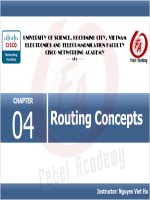Chapter+04 b+ message+ authentication+ codes
Bạn đang xem bản rút gọn của tài liệu. Xem và tải ngay bản đầy đủ của tài liệu tại đây (1.12 MB, 18 trang )
Cryptography and Network Security
Chapter 4 – Part B
Message Authetication Codes
Lectured by
Nguyễn Đức Thái
Outline
Message Authentication Requirements
Message Authentication Functions
Basic Use of MACs
MACs based on Hash Functions: HMAC
2
Message Authentication
Message authentication is a mechanism or service
used to verify the integrity of a message.
Message authentication assures that data received
are exactly as sent by (i.e., contain no modification,
insertion, deletion, or replay) and that the purported
identity of the sender is valid.
Symmetric encryption provides authentication
among those who share the secret key.
3
Message Authentication
A message authentication code (MAC) is an
algorithm that requires the use of a secret key.
A MAC takes a variable-length message and a secret
key as input and produces an authentication code.
A recipient in possession of the secret key can
generate an authentication code to verify the
integrity of the message
One way: a MAC is to combine a cryptographic hash
function in some fashion with a secret key
Another way: to use a symmetric block cipher in
such a way that it produces a fixed-length output for
a variablelength input
4
Message Authentication Requirements
Disclosure
• Release of message contents
to any person or process not
possessing the appropriate
cryptographic key
Traffic analysis
• Discovery of the pattern of
traffic between parties
Masquerade
• Insertion of messages into
the network from a
fraudulent source
Content modification
• Changes to the contents of a
message, including insertion,
deletion, transposition, and
modification
Sequence modification
• Any modification to a
sequence of messages
between parties, including
insertion, deletion, and
reordering
Timing modification
• Delay or replay of
messages
Source repudiation
• Denial of transmission of
message by source
Destination repudiation
• Denial of receipt of
message by destination
5
Message Authentication
Message authentication is a procedure to verify that
received messages come from the alleged source
and have not been altered.
Message authentication may also verify sequencing
and timeliness
A digital signature is an authentication technique
that also includes measures to counter repudiation
by the source.
6
Message Authentication Functions
Two levels of
Lower level
functionality:
• There must be some sort of function
that produces an authenticator
• Hash function
• A function that maps a
message of any length into a
fixed-length hash value
which serves as the
authenticator
• Message encryption
• The ciphertext of the entire
message serves as its
authenticator
• Message authentication code
(MAC)
Higher-level
•Uses the lower-level function as a primitive in an
authentication protocol that enables a receiver to
verify the authenticity of a message
• A function of the message
and a secret key that
produces a fixed-length
value that serves as the
authenticator
7
Message Encryption
8
Internal and External Error Control
9
TCP Segment
10
Public Key Encryption
The straightforward use of public-key encryption
provides confidentiality but not authentication
To provide both confidentiality and authentication, A
can encrypt M first using its private key which
provides the digital signature, and then using B’s
public key, which provides confidentiality
Disadvantage is that the public-key algorithm must
be exercised four times rather than two in each
communication
11
Basic Uses of MAC
12
Requirements for MAC
Taking into account
the types of attacks,
the MAC needs to
satisfy the following:
The first requirement
deals with message
replacement attacks,
in which an opponent
is able to construct a
new message to
match a given MAC,
even though the
opponent does not
know and does not
learn the key
The second
requirement
deals with the
need to thwart a
brute-force
attack based on
chosen plaintext
The final
requirement
dictates that the
authentication
algorithm should
not be weaker
with respect to
certain parts or
bits of the
message than
others
13
Brute-Force Attacks
Requires known message-tag pairs
• A brute-force method of finding a collision is to pick
a random bit string y and check if H(y) = H(x)
Two lines of attack:
• Attack the key space
• If an attacker can determine the MAC key then it is possible to
generate a valid MAC value for any input x
• Attack the MAC value
• Objective is to generate a valid tag for a given message or to find a
message that matches a given tag
14
Cryptanalysis
Cryptanalytic attacks seek to exploit some property
of the algorithm to perform some attack other than
an exhaustive search
An ideal MAC algorithm will require a cryptanalytic
effort greater than or equal to the brute-force effort
There is much more variety in the structure of MACs
than in hash functions, so it is difficult to generalize
about the cryptanalysis of MACs
15
MACs based on Hash Functions: HMAC
There has been increased interest in developing a
MAC derived from a cryptographic hash function
Motivations:
• Cryptographic hash functions such as MD5 and SHA
generally execute faster in software than symmetric block
ciphers such as DES
• Library code for cryptographic hash functions is widely
available
HMAC has been chosen as the mandatory-toimplement MAC for IP security
Has also been issued as a NIST standard (FIPS 198)
16
Summary
Message Authentication Requirements
Message Authentication Functions
Basic Use of MACs
MACs based on Hash Functions: HMAC
17
References
1. Cryptography and Network Security, Principles
and Practice, William Stallings, Prentice Hall,
Sixth Edition, 2013
18









